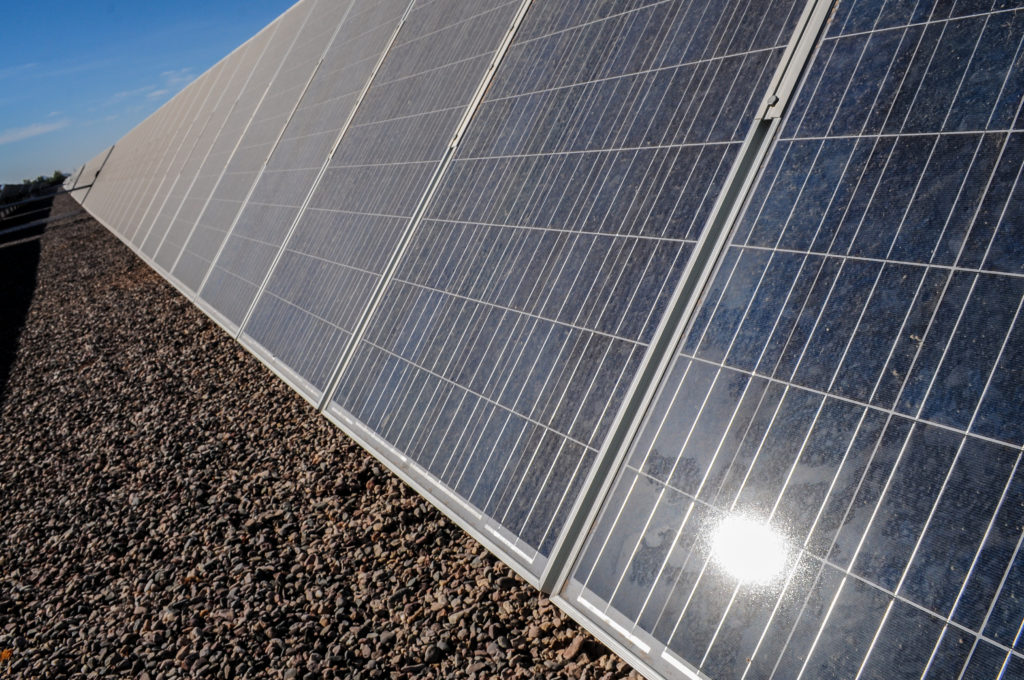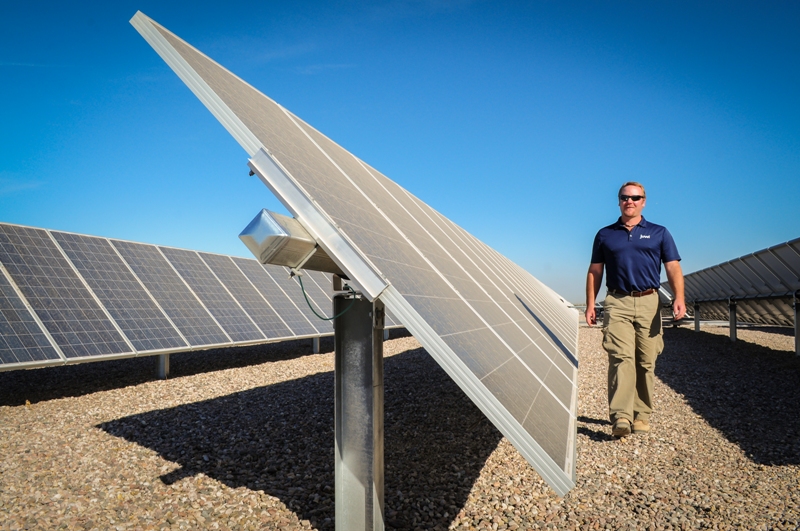(Queen Creek, Arizona) — In the remote southeast corner of Maricopa County, about 30 miles from Phoenix, Arizona, the approximately 90,000 crystalline panels of a new solar plant go completely unnoticed by motorists driving on Queen Creek Road, between Ellsworth Road and Ironwood Road.
This solar farm, located in the Town of Queen Creek and built on 148 acres of land, is surrounded by a brick fence that hides it from street-level sight. Inside the walls, however, the thousands and thousands of crystalline panels aligned in perfect formation resemble a powerful, yet silent army, giving the onlooker an unusual display of solar energy technology.
Going into the site and driving on a long dirt road in the midst of the solar plant, the visitor can’t help but to get a somewhat eerie feeling of perfect solitude and science fiction technology, a scenario that could be well borrowed from an old episode of The Twilight Zone, the successful television show of the late 50s and early 60s.
Related → The white amur fish: an unseen guardian of Central Arizona’s water canals
The year, nevertheless, is 2012, and the Queen Creek Solar Plant to be dedicated today, November 14 doesn’t have to do anything with the future but with a present reality where solar technology is used to produce power for Arizona residents with an effective, low maintenance approach
The uniformity of the thousands of crystalline panels is only broken by the bright, orange safety vest of Kelly Hoyt, who steps out of an office to talk to Barriozona Magazine about the plant. Hoyt is the construction manager for the site and a Juwi Solar, Inc. employee, the Colorado-based company that constructed the plant.

development of the solar energy industry within Arizona. It will produce an amount
of energy equal to that needed to serve the electrical needs of 3,300 SRP’s
customers. Photo: Eduardo Barraza | Barriozona Magazine © 2012
The solar plant, a source of renewable energy
Salt River Project (SRP), a primary public utility company in Arizona that provides power and water management services, secured a 20-year contract to acquire all the solar energy generated by this new photovoltaic plant. Photovoltaics is, in basic terms, a conversion method that turns light into electricity.
The solar energy produced by this 19-megawatt plant that began operations on October 3, is a source of clean and renewable energy. For SRP, it represents an addition to their blend of energy resources and a step toward one of its long-term goals.
Natural resources such as sunlight, rain, or wind are considered renewable energy since they constantly replenish naturally.
“At SRP, what we are doing is looking at different ways to generate electricity,” said Patricia Garcia-Likens, a spokesperson for SRP. “We’ve traditionally done fossil fuels, whether is coal or natural gas, but we also have a commitment to looking at renewable energy.”
Garcia-Likens said SRP has a goal to produce at least 20 percent of their generation through sustainable resources by the year 2020, that is, renewable and energy-efficiency programs. This, she added, will help SRPs customers to use less electricity.
“What we’re looking at here is 90,000 solar panels individually placed on 148 acres. The panels generate 19 megawatts of electricity, enough for 3,300 Arizona homes,” explained Garcia-Likens.
A megawatt represents one million watts and is a standard term of measurement for bulk electricity.
The Queen Creek solar plant is SRPs second largest-scale solar plant. The first plant is located in Florence, Arizona, a small town located about 65 miles southeast of Phoenix.
The plant is owned by Public Service Enterprise Group (PSEG), one of the ten largest electric companies in the country. Juwi Solar, Inc., the company that built the plant, is an engineering, procurement, and construction contractor of solar power plants.
The construction of the plant
Kelly Hoyt, the construction manager, said that the location of the Queen Creek Solar Farm is conveniently located near SRPs transmission lines.
“This is one of the benefits of solar energy,” said Hoyt. “With solar energy you can build the plants right here, next to your population, and also next to transmission lines.”
Hoyt’s background is in the gas and coal fields and their environmental side. Eventually, he moved into the renewable energy field.
“Its the same type of atmosphere; it’s construction,” said Hoyt.
Regarding his experience in building solar farms, he explains that in contrast with other sources of energy, they can be built in a variety of areas.
“We can either build [solar plants] in residential areas, commercial areas or agricultural areas. In this particular case, this kind of spot was close to transmission lines. The community was receptive to us building a site here. We usually work with the local utility provider [to determine] what’s close, what’s reachable economically.”
Hoyt said that building the plant included working with the local municipality, doing some type of grading and prepping the site -which was previously a cotton field-, as well as creating a staging area of half a mile.
According to Hoyt, at the peak of the plants construction, an average of 135 people worked at the site, and overall about 200 people. Providing maintenance to the finished and operating solar plant, however, it takes only from one to five workers on site.
“We monitor the production of the facility from our home office in Boulder, Colorado; that requires a few engineers in Boulder and some electrical people locally.”
And indeed, at the time this story was being produced at the solar plant, except for a service truck that came to the site and left in a few minutes, Garcia-Likens and Barriozona’s reporter, Hoyt was the only person on site.
In the midst of 90,000 crystalline panels and in this far corner of Maricopa County,Hoyts job gives the impression of being a solitary one. Hoyt laughs about that.
“It is not definitely a lonely job because when we were constructing it we had multiple subcontractors at the same time; we had electrical [workers], we had landscaping [workers], all kinds. There’s continual permitting, coordinating with SRP.”
Nevertheless, in the finished solar plant, Hoyts figure among the panels gives the onlooker a great sight of man and the technology he can build.
Trivia
The generation of solar energy starts with the modules -DC power. From the modules, it goes to the power stations. Inverters convert it to AC power. At that point, it’s a certain voltage that goes to the transformer which the plant workers step it up to 69,000 volts. SRP receives it – they basically have two lines – one goes in one direction, one goes in another direction to feed the lines.
- This solar plant can feed both lines.The solar plant requires very minimal maintenance
- Panels don’t need to be washed
- Dust doesn’t really affect the generation
- No water is needed to generate power
- The crystalline panels operate on a single-axis tracking system
- The construction of the plant did bring a lot of jobs to the local community and house rentals
- In 2012, SRP is serving 949,000 customers
SRP has a community solar program for customers to invest in solar energy from plants like Queen Creek Solar without having to install solar panels in their homes
📸 View more photos of the solar plant in Queen Creek, Arizona
© 2012 - 2024, Eduardo Barraza. All rights reserved.





